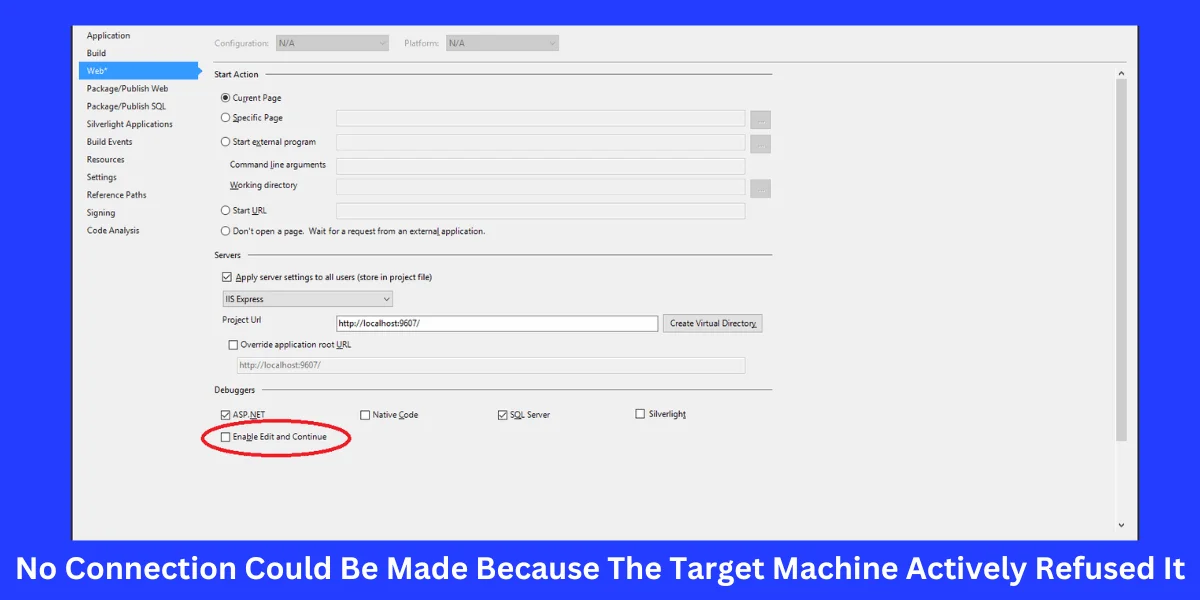Encountering the error message No Connection Could Be Made Because the Target Machine Actively Refused It can be frustrating, especially when you need your application or server to work seamlessly. This error suggests that your system’s connection attempt to a target machine (server or device) has been denied. It can affect everything from web servers to local applications and remote services.
In this comprehensive guide, we’ll delve into what this error means, explore its common causes, discuss how to troubleshoot it effectively, and outline practical solutions. Additionally, we’ll look at the benefits of maintaining a stable connection environment and answer some frequently asked questions about this error.
Also raed: Grace Charis Age | kelly bates asks supporters not to take out their anger on nbc 10
1. What Does “No Connection Could Be Made Because the Target Machine Actively Refused It” Mean?
The error message “No Connection Could Be Made Because the Target Machine Actively Refused It” typically occurs when an application, service, or script tries to connect to a remote server or machine but is denied. This often happens when a client (such as a web browser, API call, or other software) attempts to connect to a server, and the server does not respond positively to the request.
This error is primarily related to TCP/IP connections, where the server actively refuses the connection request rather than simply failing to respond. This means that the connection attempt was detected and explicitly denied by the server, rather than ignored or lost.
2. Common Causes of Connection Refusal
Understanding why “No Connection Could Be Made Because the Target Machine Actively Refused It” occurs is key to troubleshooting and resolving it. Below are the most common causes:
- Firewall Blocking the Connection: Firewalls can block incoming connections, especially if the port or application is not explicitly allowed.
- Service Not Running: The service you are trying to connect to might not be running on the target machine, leading to a refused connection.
- Incorrect Port Configuration: The application might be trying to connect to the wrong port, which the server does not listen to.
- IP Restrictions: The target server might have restrictions based on IP addresses, blocking unauthorized or unknown IPs.
- Security Software Interference: Antivirus or other security software can sometimes interfere with connection requests, blocking them as a precaution.
- Misconfigured Network Settings: Incorrect proxy settings, DNS misconfigurations, or routing issues can lead to connection refusal errors.
- Connection Limits Exceeded: Servers sometimes have limits on the number of connections they can handle, and exceeding this limit can cause refusals.
3. How to Troubleshoot the “Target Machine Actively Refused It” Error
Troubleshooting the “No Connection Could Be Made Because the Target Machine Actively Refused It” error involves checking several potential issues systematically. Here are the steps:
- Check if the Service is Running: Ensure that the target service or application is up and running on the target machine. For instance, check if the web server service (e.g., Apache, Nginx) is active.
- Review Firewall Rules: Inspect the firewall settings on both the client and the server. Make sure that the necessary ports are open and not blocked by firewall rules.
- Verify Port and IP Address: Double-check the IP address and port number that your application is trying to connect to. Ensure they match the server’s listening address and port.
- Examine Security Software: Check any installed security software (antivirus, anti-malware) that might be blocking the connection attempts and add exceptions if necessary.
- Inspect Network Configurations: Review network configurations such as DNS settings, proxies, and routing paths that might affect the connection.
- Use Diagnostic Tools: Utilize network diagnostic tools like
ping,telnet,tracert, ornetstatto determine the connection status and identify where the failure occurs.
4. Step-by-Step Solutions to Fix the Error
Follow these practical steps to resolve “No Connection Could Be Made Because the Target Machine Actively Refused It”:
Step 1: Restart the Target Service
- Sometimes, the service may have stopped or failed to start correctly. Restarting the service can refresh the connection.
Step 2: Adjust Firewall Settings
- Access your firewall settings and ensure that the required ports (such as port 80 for HTTP or port 443 for HTTPS) are open. Add a firewall rule to allow traffic on these ports.
Step 3: Check Port Availability
- Use the
netstat -ancommand to list open ports on your machine and confirm that the service is listening on the correct port.
Step 4: Update Network Settings
- Verify that the DNS and proxy settings are correct and not causing connection issues. Correct any discrepancies that could be impacting the connection.
Also read: Top 10 Low Taper Fade Styles for Men in 2024 | Thejavasea.me Leaks Aio-Tlp
Step 5: Disable Security Software Temporarily
- Temporarily disable your antivirus or security software to see if it is blocking the connection. If disabling the software resolves the issue, adjust the settings to allow the connection.
Step 6: Test with Different IP/Port
- Try connecting with different IP addresses or ports to determine if the problem is specific to one configuration.
5. Best Practices for Preventing Connection Refusal

To minimize the chances of encountering the “No Connection Could Be Made Because the Target Machine Actively Refused It” error, consider the following best practices:
- Regularly Update Firewall Rules: Ensure your firewall settings are up-to-date and configured correctly to allow legitimate connections.
- Monitor Services Continuously: Use monitoring tools to keep an eye on critical services, ensuring they are running and available.
- Use Correct Port Management: Manage and document the ports used by various services, ensuring they don’t conflict with each other.
- Implement Security Best Practices: Regularly audit and update security policies to ensure that they do not inadvertently block necessary connections.
- Limit Connection Attempts: Configure servers to handle the expected number of connections and manage load balancing to distribute requests efficiently.
Also raed: Amazon Just Walk Savannah GaperezTechCrunch | Jaidyn Alexis Age
6. Benefits of Proper Connection Management
Understanding and managing connection issues like “No Connection Could Be Made Because the Target Machine Actively Refused It” can offer numerous advantages:
- Improved Reliability: Ensuring that all necessary services are properly configured leads to more reliable connections and reduced downtime.
- Enhanced Security: Properly managed connections reduce the risk of unauthorized access while maintaining necessary connectivity.
- Increased Efficiency: Quick identification and resolution of connection issues streamline operations, making systems more efficient.
- Better User Experience: Minimizing connection errors leads to a smoother user experience for applications and services.
- Proactive Troubleshooting: Proactively managing network settings and firewall rules helps prevent common connectivity issues.
Frequently Asked Questions (FAQs)
Q1: How can I check if the service is running on the target machine?
You can use system-specific commands like systemctl status for Linux or check the Services panel on Windows to ensure the service is running.
Q2: Can incorrect credentials cause this error?
Incorrect credentials usually cause authentication errors, not connection refusal, but some servers might reject connections from unauthorized users.
Q3: Is disabling the firewall a good way to test this error?
Disabling the firewall can help diagnose the issue but should not be used as a long-term solution. Instead, configure firewall rules to allow the necessary connections.
Q4: Can high network traffic cause this error?
High network traffic might lead to timeouts but typically does not cause an active refusal unless configured as part of server overload protection.
Q5: What should I do if the error persists despite trying all solutions?
If the error persists, consult network logs, review server configurations, or seek help from a network administrator for deeper diagnostics.
By thoroughly understanding and addressing the factors contributing to the “No Connection Could Be Made Because the Target Machine Actively Refused It” error, you can maintain robust and reliable connectivity in your digital environment.
